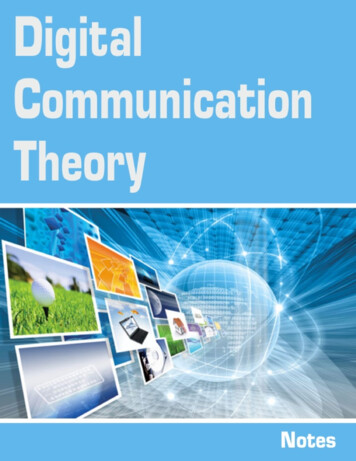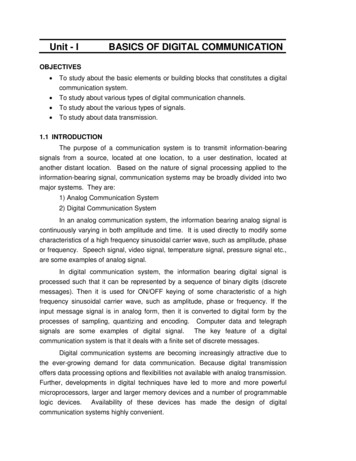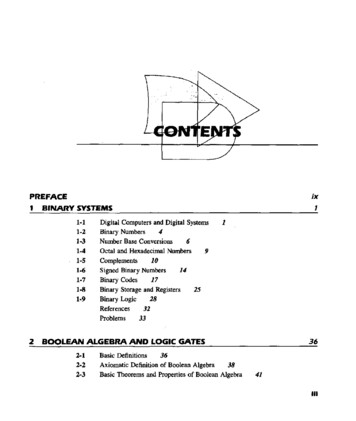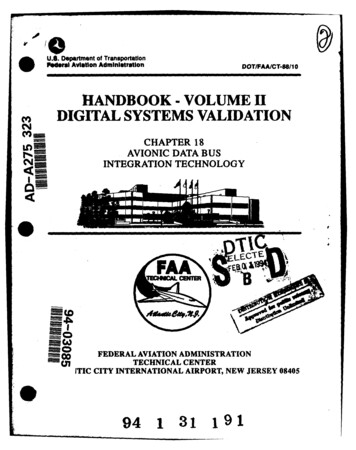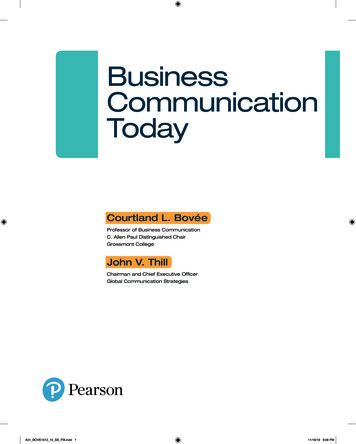
Transcription
Communication Systems IIDr. Wa’il A.H. HadiDigital Communication SystemsThe term digital communication covers a broad area ofcommunications techniques, including digital transmission and digitalradio.Digital transmission, is the transmitted of digital pulses betweentwo or more points in a communication system.Digital radio, is the transmitted of digital modulated analogcarriers between two or more points in a communication system. Why DigitalThere are many reasons The primary advantage is the ease with which digital signals,compared to analog signal, are regenerative.The shape of the waveform is affected by two mechanisms:(1) As all the transmission lines and circuits have some nonidealtransfer function, there is a distorting effect on the ideal pulse.(2) Unwanted electrical noise or other interference further distorts thepulse waveform.Both of these mechanisms cause the pulse shape to degrade as afunction of distance.During the time that the transmitted pulse can still be reliablyidentified, the pulse is thus regenerated. The circuit that perform thisfunction at regular intervals along a transmission system are calledregenerative repeaters.1
Communication Systems IIDr. Wa’il A.H. Hadi Digital circuits are less subject to distortion and interference thananalog circuits. Digital circuits are more reliable and can be produced at lower costthan analog circuits. Also, digital hardware lends itself to moreflexible implementation than analog hardware. Digital techniques lend themselves naturally to signal processingfunctions that protect against interference and jamming. Much data communication is computer to computer, or digitalinstrument or terminal to computer. Such digital terminations arenaturally best served by digital link.Communication System ModelsGenerally, there are two types for communication system models,base-band model and pass-band model.In base-band model, the spectrum of signal from zero to somefrequency (i.e. carrier frequency 0). For transmission of base-bandsignal by a digital communication system, the information is formattedso that it is represented by digital symbols. Then, pulse waveforms areassigned that represented these symbols. This step referred to as pulsemodulation or base-band modulation. These waveforms can betransmitted over a cable. Base-band signal also called low-pass signal.In pass-band (or band-pass) signal, the signal has a spectralmagnitude that is nonzero for frequency in some band concentrateabout a frequencyf fCand negligible elsewhere, where fc is thecarrier frequency need to be much greater than zero. For radio2
Communication Systems IIDr. Wa’il A.H. Haditransmission the carrier is covered to an electromagnetic (EM) filed forpropagation to desired destination.MultiplexingMultiplexing is the transmission of information (either voice ordata) from more than one source to more than one destination on thesame transmission medium.Two most common methods are used, frequency divisionmultiplexing (FDM) and time division multiplexing (TDM). FDMIn FDM multiple sources that originally occupied the samefrequency spectrum are each converted to a different frequency bandand transmitted simultaneously over a single transmission medium.FDM is an analog multiplexing scheme. Figure below shows thefrequency-time plane.3
Communication Systems IIDr. Wa’il A.H. HadiIf two input signals to a mixer are sinusoids with frequencies fAand fB, the mixing or multiplication will yield new sum and differencefrequencies at fA B and fA-B. Equation below describes the effect of themixer.1cos A cos B [cos(A B) cos(A B)]2A simple FDM example with three translated voice channels is shownin figure below.4
Communication Systems IIDr. Wa’il A.H. Hadi TDMWith TDM system, transmission from multiple sources occurs onthe same transmission medium but not at the same time. Transmissionfrom various sources is interleaved in time domain.Figure below shows the time-frequency plan in TDM system, thesame communication resources is shared by assigning each of Nsymbols or users the full spectral occupancy of the system for a shortduration of time called time slot. The unused time regions between slotassignments, called guard times, act as buffer zone to reduceinterference.Figure below shows a typical TDM system: -5
Communication Systems IIDr. Wa’il A.H. HadiThe multiplexing operation consists of providing each sourcewith an opportunity to occupy one or more slots. The demultiplexingoperation consists of desloting the information and delivering the datato the intended sink.The communication switches (S1 SM) have synchronized so thatthe massage corresponding to signal(1), for example, appears on thechannel (1) output, and so on.Time is segmented in to intervals called frames. Each frame isfurther partitioned in to assignable user time slots.The simplest TDM scheme called fixed-assignment TDM. Infixed assignment TDM scheme, all of the slot has no data to sent duringa particular frame, that slot is wasted.Anothermore efficient scheme, involving the dynamicassignment of the slots rather than fixed assignment.Figure below shows the fixed assignment TDM system.Figure below shows the fixed assignment and dynamicassignment TDM system.6
Communication Systems IIDr. Wa’il A.H. HadiSampling TheoremThe link between an analog waveform and its sampled version isprovided by what is known as the sampling process.A band limited signal having no spectral components above (fmHz) can be determined uniquely by values sampled at uniform intervalsof Ts second, whereTs 12 fmStated another way, the upper limit on Ts can be expressed interms of the sampling rate, denoted7fs 1Ts
Communication Systems IIDr. Wa’il A.H. HadiThe restriction, stated in terms of sampling rate, is known as theNyquist criterion. The statement isfs 2 fmThe sampling rate ( f s 2 f m ) also called Nyquist rate.The Nyquist criterion is a theoretically sufficient condition toallow an analog signal to be reconstructed completely from a set ofuniformly spaced discrete time samples. Impulse SamplingAssume an analog waveform x(t), as shown in Fig. (a), with aFourier transform, X(f), which is zero outside the interval (-fm f fm), asshown in Fig. (b). The sampling of x(t) can be viewed as the product ofx(t) with a train of unit impulses functions, xs(t), shown in Fig. (c), anddefined as follows:x (t ) Let us choose T s (t nT )n s1, so that Nyquist rate is just satisfied.2 fmUsing shifting property of the impulse function the xs(t), shownin Fig. (e), can be given byxs (t ) x(t ) x (t ) x(t ) (t nT )n 8s
Communication Systems IIDr. Wa’il A.H. Hadi x(nT ) (t nT )n ssUsing frequency convolution property of Fourier transform, thetimeproductx(t ) x (t ) transforms to the frequency domainconvolution X ( f ) X ( f ) , where X ( f ) is the Fourier transform ofx (t) and given by1X ( f ) Ts ( f nf )sn The convolution with an impulse function simply shifts theoriginal function, as follows:X ( f ) ( f nfs ) X ( f nfs )The Fourier transform of the sampled waveform, Xs(f), can begiven by:1X s ( f ) X ( f ) X ( f ) X ( f ) [Ts1 Ts ( f nf )]sn X ( f nf )n sFigure below shows the sampling theorem using the frequencyconvolution property of the Fourier transform (Impulse sampling).9
Communication Systems IIDr. Wa’il A.H. Hadi Natural SamplingIn this way the band limited analog signal x(t), shown in Fig. (a1),is multiplied by the pulse train or switching waveform xp(t), shown inFig. (c1). Each pulse in xp(t) has width T and amplitude 1/T.The resulting sampled data sequence, xs(t), is shown in Fig. (e1)and is expressed asxs (t ) x(t ) x p (t )The periodic pulse train, xp(t), can be expressed as a Fourierseries in the form10
Communication Systems IIDr. Wa’il A.H. Hadix p (t ) andcn j 2 nf s tce nn 1nTsin c( )TsTswhere fs 2fm, T is the pulse width, and 1/T is the pulse amplitude.The envelope of magnitude spectrum of the pulse train, seen as adashed line in Fig. (d1), has characteristic sinc shape. xs (t) x(t) cne j 2 nfstn The Fourier transform of xs(t) is found as follows X s ( f ) F[x(t) cne j 2 nfst ]n For linear system the operation of summation and Fouriertransformation can be interchanged. Therefore, X s ( f ) cn F[x(t)e j 2 nfst ]n Using frequency translation property of Fourier transform, X s ( f ) cn X ( f nfs )n NoteThe sampling here is termed natural sampling, since the top ofeach pulse in the xs(t) sequence retains the shape of its correspondinganalog segment during the pulse interval.11
Communication Systems IIDr. Wa’il A.H. HadiFigure below shows the sampling theorem using the shiftingproperty of the Fourier transform (Natural sampling).12
Communication Systems IIDr. Wa’il A.H. HadiPulse ModulationIn pulse modulation some parameter of a pulse train is varied inaccordance with the massage signal.Two families of pulse modulation may be distinguished: analogpulse modulation and digital pulse modulation. In analog pulsemodulation, a periodic pulse train is used as the carrier wave, and somecharacteristics features of each pulse (e.g. Amplitude, Position, andWidth) is varied in a continuous manner in accordance with thecorresponding sample value of the message signal. Thus in analogpulse modulation, information is transmitted basically in analog form,but the transmission takes place at discrete times.In digital pulse modulation, on the other hand, the massage signalis represented in a form that is discrete in both time and amplitude;thereby permitting its transmission in digital form as a sequence ofcoded pulses.(1) Pulse Amplitude Modulation (PAM)PAM is the simplest and most basic form of analog pulsemodulation. In PAM the amplitude of regularly spaced pulses arevaried in proportion to the corresponding sample values of a continuousmessage signal, the pulses can be of a rectangular form or otherappropriate shape.PAM as defined here is somewhat similar to natural samplingwhere the message signal is multiplied by a periodic train ofrectangular pulses. However, in natural sampling the top of each13
Communication Systems IIDr. Wa’il A.H. Hadimodulated rectangular pulse varies with the message signal, whereas inPAM it is maintained flat.The waveform of PAM signal is shown in figure below.There are two operations involved in the generation of the PAMsignal:(i) Instantaneous sampling of the message signal every Ts second,where the sampling rate fs 1/Ts is chosen in accordance with thesampling theorem.(ii)Lengthening the duration of each sample so obtained to someconstant value ( ).14
Communication Systems IIDr. Wa’il A.H. Hadi PAM/TDM SystemSuppose we wish to time multiplexed two signals using PAM.Let us assume that both input signal f1(t) and f2(t) are low pass, andband limited to 3KHz. The sampling theorem states that each must besampled at a rate no less than 6KHz. This requires a 12KHz minimumclock rate for the two channel system. Figure below shows the blockdiagram of PAM/TDM system.The time multiplex PAM output might appear some thing likethat shown below.15
Communication Systems IIDr. Wa’il A.H. HadiThe time spacing between adjacent samples in the time multiplexsignal waveform (Tx), can be defined asTx Tsnwhere Ts sampling rate, and n number of input signals.To prevent any irretrievable loss of information in the compositewaveform then requires that bandwidth Bx of LPF must satisfy thecriterionBx 12T xAt the receiver the composite time multiplexed and filteredwaveform must be resampled and separated into the appropriatechannel. One the pulses are separated, the normal samplingconsiderations applies and the analog reconstruction of signals can beobtained by LPF. The block diagram of PAM/TDM receiver is shownbelow.16
Communication Systems IIDr. Wa’il A.H. Hadi Sample and Hold CircuitFigure below shows the sample and hold circuitThe switch closes only when that particular channel is to besampled. If the source impedance r is small, the capacitor voltagechanges to the input voltage within the time that switch is closed.The load impedance R is arranged to be high so that the capacitorretains the voltage level until the switch is closed again. Therefore thesample and hold circuit accepts only those values of the input whichoccur at the sampling times and then holds them until the next samplingtime.Example:Channel 1 of two channels PAM system handles 8KHz signal.Channel 2 handles 10 KHz signals. The two channels are sampled atequal intervals of time using very narrow pulses at the lowest frequencythat is theoretical adequate. The sampled signals are time multiplexedand passed through a LPF before transmission.17
Communication Systems IIDr. Wa’il A.H. Hadi(1) What is the minimum clock frequency of the PAM system?(2) What is the minimum cut off frequency of LPF used beforetransmission that will preserve the amplitude information on theoutput pulses?(3) What would be the minimum bandwidth if these channels werefrequency multiplexed, using AM technique and SSB technique?Solution(1)f s1 2 * f m1f s1 2 * 8 16KHzf s 2 2 * f m2f s 2 2 * 10 20 KHzIn order to sample channel 2 adequatelyf s f s 2 20 KHz The minimum clock rate n * f s 2 * 20 40 KHz(2)Ts 11 50 secf s 20 KHz n 2Ts 50 25 secn21 Bx 2TxTx B x 20 KHz18
Communication Systems IIDr. Wa’il A.H. Hadi(4) For AMmin .BW . 2( f m1 f m 2 ) 2(8 10) 36 KHzFor SSBmin .BW . f m1 f m 2 8 10 18 KHzH.WTwo low pass signals, each band limited 4KHz, are to be timemultiplexed into a single channel using PAM. Each signal is impulsesampled at a rate 10KHz. The time multiplexed signal waveform isfiltered by an ideal LPF before transmission.(a) What is minimum clock frequency of the system?(b) What is the minimum cut off frequency of the LPF?(c) In the receiver side, determine the minimum and maximumacceptable bandwidth of the LPF used in retrieving the analogsignal?Ans. (a) 20KHz (b) 10KHz (c) 4KHz, 6KHz.19
Communication Systems IIDr. Wa’il A.H. Hadi(2) Other Types of Analog Pulse Modulation (PWM&PPM)One type of pulse timing modulation uses constant amplitudepulses whose width is proportional to the value of message signal at thesampling instants. This type is designated as pulse width modulation(PWM) or pulse duration modulation (PDM) is also called.Another possibility is to keep both the amplitude and the width ofthe pulses constant but vary the pulse position in proportion to thevalue of message signal at sampling instant. This is designated as pulseposition modulation (PPM).PAM, PWM and PPM waveforms for a given message signal areshown below: -In PWM, the signal f(t) is sampled periodically at a rate fastenough to satisfy the requirements of the sampling theorem. At eachsampling instant a pulse is generated with fixed amplitude and a width20
Communication Systems IIDr. Wa’il A.H. Hadithat is proportional to the sample value of f(t). A minimum pulse widthis assigned to the minimum value of f(t).In PPM, these are sent as constant width, constant amplitudepulses. The minimum pulse delay is used to designate the minimumvalue of f(t) and the change in delay is proportional to the modulatingsignal. The constant of proportionality is the modulation constant.Generation of PWM & PPMGeneration of PWM and PPM commonly employs variouscombinations of a sample and holed circuit, a precision ramp voltagegenerator and a comparator. The block diagram of a typical circuit forgeneration PWM and PPM is shown in figure below: -21
Communication Systems IIDr. Wa’il A.H. HadiThe ramp generator produces a precision ramp voltage which haspeak to peak amplitude slightly larger than the maximum amplituderange of the input signals. This ramp voltage is the basis for theamplitude to timing conversion and therefore must be accuratelyknown.The comparator is a high gain amplifier intended for two statedoperation. If input signal is higher than a preset reference level, theoutput is held in one state (i.e. a given voltage level). Whenever theinput signal level is less than the reference level, the output is held inthe other state. Which output state is present, then, depends uponwhether the input is above and below the threshold (reference level) ofthe comparator.The voltage reference level of the comparator is adjust so thatthere is always an intersection with the sum of the sample and holdcircuit and ramp voltage. In this system, the first crossing of thereference level indicates the clock timing and the second crossinggenerates the variable trailing edge.A convenient way to generate PPM is to use PWM waveformgenerated above and then trigger a constant width pulse generationthose edge of the PWM waveform with a negative slope.22
Communication Systems IIDr. Wa’il A.H. Hadi Signal to noise ratio in analog pulse modulationThe performance of analog pulse modulation system in thepresence of additive noise is investigated here. PAMNoise is added in the transmission of the PAM signal asillustration in figure below.The noise occurring between pulses adds noise power to thetransmission without any increase in signal power. To avoid this, asynchronized gating circuit is used in the receiver to accept samplesonly when the signal is known to be present.We shall assume that the signal and the additive noise present inthe input to the PAM receiver are band limited and that the conditionsof the sampling theorem are satisfied. Because the PAM receiver islinear, we can apply the signal and the noise separately measures theirpower, and then combine. The sampling and low pass filtering at thereceiver reproduce the band limited signal and noise spectra within aconstant, as shown in figure below.23
Communication Systems IIDr. Wa’il A.H. HadiS 02 (t ) K S i2 (t )Thusn02 (t ) K ni2 (t )So thatS0S iN0 Ni Pulse timing modulationAlthough the pulses to convey the information may be generatedwith extremely short (fast) rise time, after passing through a bandlimited system they have rise time which are governed by thebandwidth of the system. This rise time can be approximated by alinear ramp. As shown in figure below, so that the pulse assumes atrapezoidal shape.The position of the trapezoidal pulse is sensitive to additivenoise. If the noise voltage is assumed to vary slowly compared to therise time of the pulse, the variation in the pulse amplitude, n, may be24
Communication Systems IIDr. Wa’il A.H. Hadirepresented by a shift, , in the pulse position as shown in abovefigure.From the geometry of above figure, we have n tr Aort 2 ( r )2 n2A (1)The output signal amplitude is proportional to the modulatingsignal f(t) through a modulation constant k. S 0 (t ) kf (t )orS 02 (t ) k 2 f 2 (t ) (2)The output noise use Eq.(1)tn02 2 ( r ) 2 ni2 (t )A (3)Also we haveS i2 A 2 ( )Ts (4)and for ideal LPF (giving a nearly linear rise time)B 1tr (5)25
Communication Systems IIDr. Wa’il A.H. HadiCombining Eqs. (2) and (5) we haveS0K 2 f 2 (t ) 2 S iB N0 /TNiS0S B2 iN0Ni the S/N improvement in a PPM is proportional to the square of thebandwidth.Pulse code modulation (PCM)Pulse code modulation (PCM) is the name given to the class ofbaseband signals obtained from the quantized PAM signals by encodingeach quantized sample into a digital word. Figure below shows the stepsrequired in PCM communication.Input signalSamplerPAM signalQuantizerEncoderPCM signalThe source of information is sampled and quantized to one of Llevels, then each quantized sample is digitally encoded into a k-bitscode word.Where k log 2 LL 2kThe essential features of binary PCM are shown in figure below.Assume that an analog signal, x(t), is limited in its excursions to the26
Communication Systems IIDr. Wa’il A.H. Hadirange (-4V to 4V). The step size between quantization levels has beenset at 1V. Thus eight quantization level are employed, these located at-3.5V, -2.5V, ., 3.5V.The code number 0 may be assigned to the level at -3.5V; the codenumber 1 may be assigned to the level at -2.5V, and so on until the levelat 3.5V, which is assigned the code number 7.Each code number has its representation in binary arithmetic,ranging from 000 for code number 0 to 111 for code number 7.27
Communication Systems IIDr. Wa’il A.H. HadiFrom the above figure each sample of analog signal is assigned tothe quantization level closest to the value of the sample. Beneath theanalog waveform, x(t), are seen four representations of x(t) as follows:the natural sample value, the quantized sample value, the code numbers,and the PCM sequence. QuantizationThe objective of the quantization step in PCM process is to representeach sample by a fixed number of bits.For example, if the amplitude of PAM resulting from samplingprocess ranges between (-1V and 1V), there can be infinite values ofvoltage between (-1 and 1). For instance, one value can be -0.27689V.To assign a different binary sequence to each voltage value, we wouldhave to construct a code of infinite length. Therefore, we can take alimit number of voltage values between (-1V and 1V) to represent theoriginal signal and these values must be discrete.Assume that the quantization steps were in 0.1V increment, and thevoltage measurement for one sample is 0,58V. That would have to berounded off to 0.6V, the nearest discrete value. Note that there is a0.02V error, the difference between 0.58V and 0.6V. See figure below.Take step 12 in the curve, for example, the curve is passing through amaximum and is given tow values of 12. For the first value, the actualcurve is above 12 and for second value below 12. That error from thetrue value to the quantum value is called quantization distortion. Thisdistortion is the major source of imperfection in PCM system.28
Communication Systems II 1Dr. Wa’il A.H. Hadi15120-1101212Code valueThe more quantization level, the better quality the system willdeliver. However, increasing the number of quantization level has twomajor costs:1) The cost of designing a system with large binary code size needed.2) The time it takes to process this large number of quantizing steps bythe coder.Therefore, a very large number of quantizing levels may induceunwanted delays in the system.29
Communication Systems IIDr. Wa’il A.H. HadiUniform and Nonuniform QuantizationForm the above discussion it cam be seen that the quantization noisedepends on the step size. When the steps have uniform size thequantization called as uniform quantization.For uniform quantization, the quantization noise is the same for allsignal magnitudes. Therefore, with uniform quantization the signal tonoise ratio (SNR) is worse for low level signals than for high levelsignals.Nonuniform quantization can provide fine quantization of the weaksignal and coarse quantization of the strong signal. Thus in the case ofnonuniform quantization, quantization noise can be made proportionalto signal size. The effect is to improve the overall SNR by reducing thenoise for the predominant weak signals, at the expense of an increase innoise for the rarely occurring strong signals. Figure below compares thequantization of strong signal versus a weak signal for uniform andnonuniform quantization.30
Communication Systems IIDr. Wa’il A.H. Hadi EncodingFigure below some of the more commonly used PCMrepresentation.1) Return-to-zero (RZ) method represents a 1 by a change to thelevel for one-half the bit interval, after which the signal returns tothe reference level for the remaining half-bit interval. A 0 isindicated in this method by no change, the signal remaining at thereference level.31
Communication Systems IIDr. Wa’il A.H. Hadi2) Return-to-bias (RB) method, in this method three levels are used0, 1, and a bias level. The bias level may be chosen either belowor between the other two levels. The waveform returns to the biaslevel during the last half of each bit interval.3) Alternate Mark Inversion (AMI), in this method the first binaryone is represented by 1, the second by -1, the third by 1, etc.The AMI representation is easily derived from an RZ binary code(and vice versa) by alternately inverting the 1’s. It has zeroaverage value and is widely used in telephone PCM systems.This is also referred to as a bipolar return-to-zero (BRZ)representation.4) Split-phase representations eliminate the variation in averagevalue using symmetry. In the Manchester split-phase method, a 1is represented by a 1 level during the first half-bit interval, thenshifted to the 0 level for the latter half-bit interval; a 0 isindicated by the reverse representation. In the split-phase (mark)method, a similar symmetric representation is used expect that aphase reversal relative to the previous phase indicates a 1 (i.e.mark) and no change in phase is used to indicate a 0.5) Nonreturn-to-zero (NRZ) representations reduce the bandwidthneeded to send PCM code. In NRZ (L) representations a bit pulseremains in one of its two levels for the entire bit interval. In NRZ32
Communication Systems IIDr. Wa’il A.H. Hadi(M) method a level change is used to indicate a mark (i.e a 1) andno level change for a 0; the NRZ (S) method uses the samescheme except that a level change is used to indicate a space (i.e.a 0). Both of these are examples of the more generalclassification NRZ (I) in which a level change (inversion) is usedto indicate one kind of binary digit and no level change indicatesthe other digit. Note that use of split-phase and NRZrepresentations require some added receiver complexity todetermine the clock frequency.6) Delay modulation (Miller code), in this method a 1 isrepresented by a signal transition at the midpoint of a bit interval.A 0 is represented by no transition unless it is followed byanother 0, in which case the signal transition occurs at the end ofthe bit interval. In this method, a succession of 1’s and asuccession of 0’s each are represented by a square wave at the bitrate, but one is delayed a half-bit interval from the other. Noise consideration in PCM systemThe performance of a PCM system is influenced by two majorsources of noise.1) Channel noise, which is introduced anywhere between thetransmitter output and the receiver input, channel noise is alwayspresent, once the equipment is switched on.33
Communication Systems IIDr. Wa’il A.H. Hadi2) Quantization noise, which is introduced in the transmitter and iscarried all the way along to the receiver output.Quantization NoiseThe peak signal to r.m.s noise power ratio is given byS0 3L2N0S0) dB 4.8 20 log10 LN0where L number of quantizer level.S0 peak signal power.N0 r.m.s noise power.Increasing L increases the number of code pulses and hence thebandwidth. We can thus relate SNR to bandwidth. This is easily doneby noting thatL nmwhere m the number pulses in code group.n the number of code levels. andS0 3n 2 mN0S0) dB 4.8 20m log10 nN034
Communication Systems IIDr. Wa’il A.H. HadiIn particular, for binary code n 2.S0) dB 4.8 6mN0Since the bandwidth is proportional to m, the output SNR increasesexponentially with bandwidth.Intersymbol interference (ISI) and pulse shaping to reduce ISIConsider the sequence of pulses shown in figure below. Althoughthese are shown as binary pulses, they could well be pulses of identicalshape, but of arbitrary height. They are shown recurring at Ts second,where Ts is the sampling interval.System filtering causes these pulses to spread out as they traversethe system. And they overlap into adjacent time slot as shown. At thereceiver the original pulse message may be derived by sampling at thecenter of each time slot, and then basing a decision on the amplitude ofthe signal measured at that point.35
Communication Systems IIDr. Wa’il A.H. HadiThe signal overlapped into adjacent time slots may, if too strong,results in an erroneous decision. Thus, as an example, in the case ofabove figure the 0 transmitted may appear as a 1 if tails of adjacentpulses add up to too high a value.This phenomenon of pulse overlap and the resultant difficultywith receiver decision is termed intersymbol interference (ISI).Nyquist investigated the problem of specifying a received pulseshape so that no ISI occurs at the detector. He showed that thetheoretical minimum system bandwidth needed to detect Rssymbol/second without ISI is Rs/2 Hz. This occurs when the systemtransfer function, H(f), is made rectangular as shown in figure below.36
Communication Systems IIDr. Wa’il A.H. HadiNote that, when H(f) is such an ideal filter with bandwidth 1/2T,its impulse responseth(t ) sin c ( )TTherefore, the bandwidth required to detect 1/T symbol/sec. is1/2T Hz.The Nyquist pulse shape is not physically realizable since itdictates a rectangular bandwidth characteristic. Also, with such acharacteristic, the detection process would be very sensitive to smalltiming error.One frequently used system transfer function H(f) is called theraised cosine filter. It can be expressed as 1 [( 2T f ) 1 r ] 1H ( f ) [1 cos()]2r 2 0where r 0 0 is called roll-off factor. absolute bandwidth. 0 12T minimum Nyquist bandwidth.371 r2T1 r1 r f 2T2T1 rf 2T0 f
Communication Systems IIDr. Wa’il A.H. HadiTherefore, the bandwidth may be given by:-B.W (1 r )2T Note: If r 0 0 , is the Nyquist minimum bandwidth. If r 0 2 0 1T.The corresponding impulse response for the H(f) of raised cosinefilter is:- t rtcosT ) (T )h(t ) ( t4rt1 ( )2T2TsinFigure below shows the raised cosine filter characteristics.38
Communication Systems IIDr. Wa’il A.H. Hadi39
Communication Systems IIDr. Wa’il A.H. Hadi Channel CapacityThe maximum rate of transmission was found by Shannon to begiven by:-C W log 2 (1 S)NShannon’s maximum capacity expression provides an upper bound onthe rate at which one can
Digital Communication Systems The term digital communication covers a broad area of communications techniques, including digital transmission and digital radio. Digital transmission, is the transmitted of digital pulses between two or more points in a communication system. Digital radio, is the transmitted of
